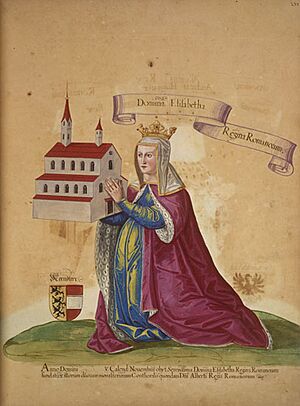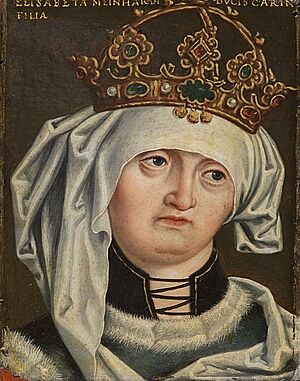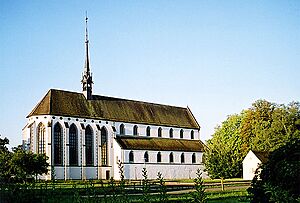Elisabeth of Carinthia, Queen of the Romans facts for kids
Quick facts for kids Elisabeth of Carinthia |
|
|---|---|

Queen Elizabeth, donor portrait, 15th century
|
|
| Queen consort of the Romans | |
| Tenure | 27 July 1298 – 1 May 1308 |
| Born | c. 1262 Munich, Bavaria |
| Died | 28 October 1312 Königsfelden, Swabia |
| Burial | Saint Paul's Abbey, Carinthia |
| Spouse | Albert I of Germany |
| Issue Detail |
Rudolph I of Bohemia Frederick the Fair Leopold I, Duke of Austria Albert II, Duke of Austria Henry the Gentle Otto, Duke of Austria Anna, Margravine of Brandenburg and Duchess of Wrocław Agnes, Queen of Hungary Elizabeth, Duchess of Lorraine Catherine, Duchess of Calabria |
| House | House of Gorizia |
| Father | Meinhard, Duke of Carinthia |
| Mother | Elisabeth of Bavaria |
Elisabeth of Carinthia (also known as Elisabeth of Tyrol) was an important royal figure who lived from about 1262 to 1312. She became the Duchess of Austria in 1282 and later the Queen of the Romans from 1298 to 1308. She gained these titles by marrying Albert I of Germany, who belonged to the powerful House of Habsburg.
Her Early Life
Elisabeth was born in Munich, a city in what was then known as Bavaria. She was the oldest daughter of Count Meinhard of Gorizia-Tyrol. Her mother was Elizabeth of Bavaria, Queen of Germany. Interestingly, her mother had been married before to King Conrad IV of Germany. This meant Elisabeth was the half-sister of Conradin, who was a king and duke himself.
Elisabeth had strong connections to powerful German rulers. She was related to earlier monarchs, like Emperor Frederick Barbarossa. She was also the niece of the dukes of Bavaria, who were important neighbors to Austria.
Becoming a Duchess and Queen
Elisabeth married Albert I of Germany in Vienna on December 20, 1274. Albert was the oldest son of Rudolf I, King of the Romans, who had just been chosen as the new King of the Romans. This marriage made Elisabeth the daughter-in-law of a future Holy Roman Emperor.
After Rudolf I won an important battle in 1278, he gave his son Albert control over the duchies of Austria and Styria. This happened at a big meeting called the Imperial Diet in Augsburg in 1282.
Albert had to share power with his younger brother for a short time. But soon, Albert and Elisabeth made their rule strong in what became the Habsburg family's main lands. Elisabeth's father, Meinhard, also helped them. He was made the Duke of Carinthia by King Rudolf I in 1286.
People described Elisabeth as clever and good at business. She even suggested building a salt production plant in Salzkammergut.
When Albert's father died in 1291, the German princes chose a different king, Adolf of Nassau. Albert had to deal with problems with the nobles in Austria. But in 1298, Adolf was removed from power. Then, Elisabeth's husband, Albert, was finally chosen as King of the Romans. This happened on June 23, 1298. A few weeks later, Adolf was defeated and killed in a battle. In 1299, Elisabeth herself was crowned Queen of the Romans in Nuremberg.
Later Years
On May 1, 1308, Elisabeth's husband, King Albert, was tragically murdered. He was killed by his nephew, John "the Parricide", near Windisch in modern-day Switzerland.
After Albert's death, Elisabeth decided to build a monastery for the Poor Clares (a group of nuns). This monastery, called Königsfelden, was built right where her husband was killed. Elisabeth died there on October 28, 1312, and was also buried there. Today, her remains are at Saint Paul's Abbey in Carinthia.
Her Children
Elisabeth and Albert had many children. Here are some of them:
- Anna (born 1275, died 1327)
- Agnes (born 1281, died 1364)
- Rudolf III (born about 1282, died 1307). He became King of Bohemia for a short time.
- Elisabeth (born 1285, died 1353)
- Frederick I (born 1289, died 1330)
- Leopold I (born 1290, died 1326)
- Catherine (born 1295, died 1323)
- Albert II (born 1298, died 1358)
- Henry the Gentle (born 1299, died 1327)
- Meinhard (born 1300, died 1301)
- Otto (born 1301, died 1339)
- Jutta (born 1302, died 1329)



